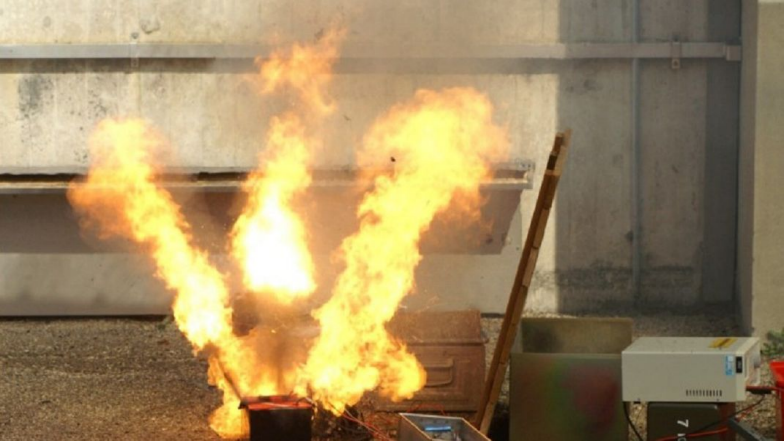Electric Vehicle Fire Incidents in China: Some Objective Data
The electric vehicle (EV) fire incidents, which seem to be never-ending, have finally got some objective data for reference. According to the data released by the Fire Rescue Department of the Emergency Management Ministry of China, a total of 640 new energy vehicle fire alarms were received in the first quarter of this year, an increase of 32% compared to the same period last year.
In comparison, the total number of fire alarms for various types of transportation was 19,000, a growth rate of 8.8% year on year. This “various types of transportation” include various categories such as cars, trucks, motorcycles, bicycles, and so on, and does not directly correspond to fuel-powered cars. Nevertheless, the 32% increase in new energy vehicle fire incidents is still high.
Does this mean that new energy vehicles are more prone to catch fire?
First of all, the data published by the Fire Rescue Department is the “year-on-year increase in the number of alarms received,” not the ratio of cars that caught fire to the market share of new energy vehicles. Therefore, the 32% increase in the number of alarms received for EV fires does not necessarily mean that the vehicles are more prone to catch fire than other types of transportation.
According to the data from the Traffic Management Bureau of the Ministry of Public Security, as of the first quarter of 2021, the number of new energy vehicles in China was 5.51 million, which has since increased to approximately 8.915 million in the first quarter of 2022, a year-on-year increase of 62%.
Compared with the expansion rate of the total number of EVs, the 32% increase in the number of fire incidents indicates that the probability of EVs catching fire is actually decreasing.
This is in line with the development trend of the industry. The new generation of EVs are safer than earlier models and have much higher sales volumes than in previous years, so the probability of catching fire is naturally decreasing. Although the number of fire incidents has increased, the probability of them occurring relative to the total number of EVs is decreasing.
However, the Fire Rescue Department judged that “the overall risk of new energy vehicle fires is higher than that of traditional vehicles,” with approximately 3,000 new energy vehicle fires occurring in 2021.
Since there is no data available for traditional vehicle fire incidents in 2021, it is impossible to compare the fire incident rates directly. Traditional vehicles have been around for much longer and are likely to include many older vehicles with poor maintenance practices. Additionally, unlike EVs which almost always trigger an alarm once they catch fire, traditional vehicles may not always trigger alarms when catching fire. Therefore, even if we learn the number of fire incidents that occurred in traditional vehicles during the same period, it is still difficult to make a direct comparison with the number of new energy vehicle fire incidents.If one had to compare the probability of fire between electric vehicles and traditional fuel-powered vehicles, it would most likely be an academic problem that requires considering a variety of variables and conducting complex weighting. More importantly, due to the significant differences in the nature of ignition and the difficulty of extinguishing fires between new energy vehicles and traditional fuel-powered vehicles, the question of which has a higher or lower probability of catching fire has become a less critical issue.
The Unsolved Problem of “Self-Contained Oxygen”
Friends who have taken high school chemistry should remember that the primary reaction of a battery is a redox reaction. Combustion is also a redox reaction, and fundamentally both involve the gain and loss of electrons by reactants. Combustion is just a more violent redox reaction, whereas batteries are gentler and more controllable.
The combustion reaction inside an internal combustion engine in a vehicle is the oxidation-reduction of the fuel and the oxygen in the air. Vehicles only carry fuel. Lithium-ion batteries, which are commonly used in electric cars, do not require any material from the outside world. Instead, the positive and negative electrodes and the electrolyte inside the battery undergo oxidation-reduction reactions and generate electricity. However, the lithium-containing oxide, which serves as the positive electrode, becomes the “oxygen” for the lithium-ion battery if an abnormal condition occurs.
It is precisely this difference in characteristics that, in the past, made the ignition accidents of fuel-powered cars diverse, ranging from minor accidents involving items within the car to major incidents such as the ignition of the gasoline tank, which burned the car into a skeleton. Once an electric car catches fire, most of the time, it will evolve into a severe fire that renders the entire car unusable and even affects innocent bystanders.

Except for certain exceptional situations, if a fuel-powered car catches fire and is discovered and treated promptly, the extinguishing difficulty will not be significant, and the burning time will not be very long. Although gasoline is also highly flammable and explosive, it can always be isolated from the air by foam or other means. However, once a lithium-ion battery starts to burn, a significant amount of water is typically required to cool it down and put out the fire.
In March of this year, a roll-on/roll-off cargo ship carrying 4,000 cars caught fire in the Atlantic and burned for a week before finally sinking because the lithium-ion batteries on board caught fire. One of the significant reasons that the cargo ship sank was that putting out a lithium-ion battery fire requires a significant amount of water, and pouring a large amount of water onto a ship at sea would clearly cause it to sink even faster.

The fire burns more violently and rapidly, and extinguishing it becomes more difficult. In April 2019, the Tesla Model S fire incident that caused a sensation in a parking garage in Shanghai led to the combustion of multiple cars in the garage. Among the many cases of electric car fires, there have been instances where the flames have reignited after being extinguished, leaving firefighters powerless to put them out and forcing them to wait for the batteries to burn out completely.# The Importance of Facing Reality in the Face of Lithium Battery Safety
The rejection of new energy vehicles by some underground parking lots has become a major issue due to the much more intense and difficult-to-extinguish nature of their fires compared to those caused by the “false accusation” of fire hazards. The complex and dense environment of underground parking lots is already disadvantageous to fire safety, and lithium-ion batteries have a bug where oxygen consumption decreases as the fire burns, which is just like electric bicycles not being allowed in elevators. It is not unreasonable for some underground parking lots to say no to electric vehicles.
Lithium-ion batteries’ inherent “talent” for combustion is not affected by minor differences in formulations, whether it’s lithium iron phosphate or ternary lithium. The assertion of car and battery companies that they are “not flammable, non-explosive” does not mean that they have a magical method of restraining lithium-ion batteries’ combustible and fierce burning properties, but rather how to prevent them from entering a dangerous collective combustion state.
If you insist on enjoying the reputation of being “fireproof,” sooner or later, reality will give you a slap in the face. If you must cater to consumers’ blind pursuit of “fireproof,” do not blame the resulting backlash.
The approach of electric car and battery companies to resist lithium-ion batteries’ ignition is not to change chemical laws so that lithium-ion batteries are not flammable, but to increase the difficulty of igniting internal battery materials as much as possible. If ignition cannot be avoided, the aim is to delay the time it takes for the entire battery pack to catch fire, providing passengers with time to escape and firefighting services with time to rescue.
These measures not only prevent external accidents but also prevent self-ignition caused by design and manufacturing flaws or improper usage. Self-ignition is often a design and manufacturing issue that manufacturers can control, while external risks cannot be eliminated by car companies, so the best course of action is to be well-prepared in advance.
To this day, some electric cars and new energy brands have yet to experience fire accidents. They are mostly conservative and cautious in terms of their three electric performance, leaving room for redundancy and protection in the event of unexpected situations. However, even so, if they encounter accidents that exceed design targets, lithium-ion batteries’ risks may still be unleashed.
However, some electric car companies have already started to steer the conversation towards a more rational and realistic direction. For example, NETA stated that “if we want to achieve a volume of one million and completely avoid self-ignition, it is fundamentally impossible from a product perspective.” When car companies discuss safety, they are now more focused on explaining safety design and measures, rather than repeating the phrase “never catches fire.”Let’s talk about gasoline cars again. As we all know, under each car there is a liquid that is as small as 50 liters, flammable and volatile. However, we rarely panic because we know that technology has done almost everything it can for gasoline tanks, and unless the situation is extremely bad, we usually have escape time when cars catch fire and burn.
The same goes for electric cars and lithium batteries. Just as no gasoline car company will publicize that their tanks will never catch fire or explode, what car companies should do is to explain how to gain more time for escape and rescue when the battery fire crisis occurs, rather than simply catering to some consumers and selling the illusory dream of “never catching fire”.
This article is a translation by ChatGPT of a Chinese report from 42HOW. If you have any questions about it, please email bd@42how.com.
